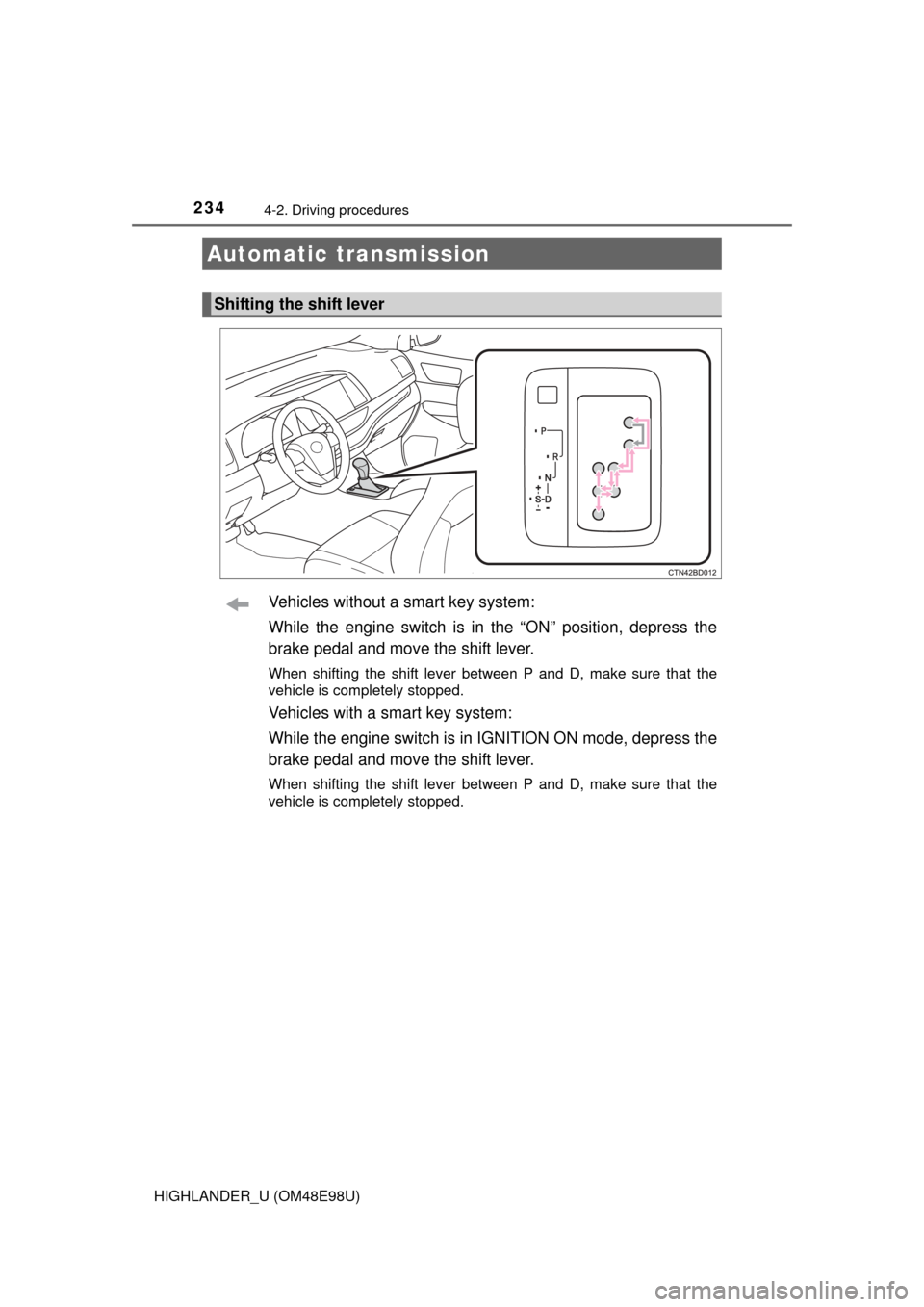2015 TOYOTA HIGHLANDER transmission
[x] Cancel search: transmissionPage 3 of 712

3
1
8 7
6
5
4
3
2
9
HIGHLANDER_U (OM48E98U)
10
3-4. Adjusting the steering wheel and mirrors
Steering wheel .................. 172
Inside rear view mirror....... 174
Outside rear view mirrors ............................. 176
3-5. Opening and closing the windows
Power windows ................. 178
Moon roof .......................... 182
Panoramic moon roof ........ 186
4-1. Before driving Driving the vehicle ............. 192
Cargo and luggage............ 201
Vehicle load limits ............. 206
Trailer towing..................... 207
Dinghy towing.................... 224
4-2. Driving procedures Engine (ignition) switch (vehicles without a
smart key system) ........... 225
Engine (ignition) switch (vehicles with a smart
key system) ..................... 228
Automatic transmission ..... 234
Turn signal lever................ 239
Parking brake .................... 240 4-3. Operating the lights and
wipers
Headlight switch ................ 241
Automatic High Beam ........ 246
Fog light switch .................. 252
Windshield wipers and washer ............................. 253
Rear window wiper and washer ............................. 255
4-4. Refueling Opening the fuel tank cap................................... 257
4-5. Using the driving support systems
Cruise control .................... 261
Dynamic radar cruise control.............................. 266
LDA (Lane Departure Alert)..... 280
Rear view monitor system ............................. 288
All-wheel drive lock switch .............................. 297
Driving assist systems ....... 298
Downhill assist control system ............................. 304
PCS (Pre-Collision System)..... 306
BSM (Blind Spot Monitor)......... 313
• The Blind Spot Monitor function......................... 317
• The Rear Cross Traffic Alert function ................ 320
4-6. Driving tips Winter driving tips .............. 323
Utility vehicle precautions ...................... 327
4Driving
Page 191 of 712

191
4Driving
HIGHLANDER_U (OM48E98U)4-1. Before driving
Driving the vehicle ............. 192
Cargo and luggage ........... 201
Vehicle load limits ............. 206
Trailer towing..................... 207
Dinghy towing ................... 224
4-2. Driving procedures Engine (ignition) switch (vehicles without a
smart key system) ........... 225
Engine (ignition) switch (vehicles with a smart
key system) ..................... 228
Automatic transmission ..... 234
Turn signal lever................ 239
Parking brake .................... 240
4-3. Operating the lights and wipers
Headlight switch ................ 241
Automatic High Beam ....... 246
Fog light switch ................. 252
Windshield wipers and washer ............................ 253
Rear window wiper and washer ............................ 255
4-4. Refueling Opening the fuel tank cap .................................. 257 4-5. Using the driving support
systems
Cruise control .................... 261
Dynamic radar cruise control ............................. 266
LDA (Lane Departure Alert) .... 280
Rear view monitor system ............................ 288
All-wheel drive lock switch .............................. 297
Driving assist systems ...... 298
Downhill assist control system ............................ 304
PCS (Pre-Collision System) .... 306
BSM (Blind Spot Monitor) ........ 313
• The Blind Spot Monitor function ......................... 317
• The Rear Cross Traffic Alert function ................. 320
4-6. Driving tips Winter driving tips ............. 323
Utility vehicle precautions ..................... 327
Page 196 of 712

1964-1. Before driving
HIGHLANDER_U (OM48E98U)
WARNING
Observe the following precautions.
Failure to do so may result in death or serious injury.
■When shifting the shift lever
● Do not let the vehicle roll backward while the shift lever is in a driving posi-
tion, or roll forward while the shift lever is in R.
Doing so may cause the engine to stall or lead to poor brake and steering
performance, resulting in an accident or damage to the vehicle.
● Do not shift the shift lever to P while the vehicle is moving.
Doing so can damage the transmission and may result in a loss of vehicle
control.
● Do not shift the shift lever to R while the vehicle is moving forward.
Doing so can damage the transmission and may result in a loss of vehicle
control.
● Do not shift the shift lever to D while the vehicle is moving backward.
Doing so can damage the transmission and may result in a loss of vehicle
control.
● Moving the shift lever to N while the vehicle is moving will disengage the
engine from the transmission. Engine braking is not available when N is
selected.
● Be careful not to shift the shift lever with the accelerator pedal depressed.
Shifting the shift lever to a gear other than P or N may lead to unexpected
rapid acceleration of the vehicle that may cause an accident and result in
death or serious injury.
Page 218 of 712

2184-1. Before driving
HIGHLANDER_U (OM48E98U)
●As stopping distance is increased when towing a trailer, vehicle-to
vehicle distance should be increa sed. For each 10 mph (16 km/h)
of speed, allow at least one vehicle and trailer length.
● Avoid sudden braking as you may skid, resulting in the trailer jack-
knifing and a loss of vehicle contro l. This is especially true on wet or
slippery surfaces.
● Avoid jerky starts or sudden acceleration.
● Avoid jerky steering and sharp turns, and slow down before making
turn.
● Note that when making a turn, the trailer wheels will be closer than
the vehicle wheels to the inside of the turn. Compensate by making
a wider than normal turning radius.
● Slow down before making a turn, in cross winds, on wet or slippery
surfaces, etc.
Increasing vehicle speed can destabilize the trailer.
● Take care when passing other vehicles. Passing requires consider-
able distance. After passing a vehicle, do not forget the length of
your trailer, and be sure you hav e plenty of room before changing
lanes.
● To maintain engine braking effici ency and charging system perfor-
mance when using engine braking, do not put the transmission in
D. If in the S mode, the transmission shift range position must be in
4 or lower.
● Instability happens more frequently when descending steep or long
downhill grades. Before descending, slow down and downshift. Do
not make sudden downshifts while descending steep or long down-
hill grades.
● Avoid holding the brake pedal down too long or applying the brakes
too frequently. This could cause th e brakes to overheat and result in
reduced braking efficiency.
Page 219 of 712
![TOYOTA HIGHLANDER 2015 XU50 / 3.G Owners Manual 2194-1. Before driving
4
Driving
HIGHLANDER_U (OM48E98U)
●Due to the added load of the trailer, your vehicle’s engine may over-
heat on hot days (at temperatures over 85 F [30C]) when drivin TOYOTA HIGHLANDER 2015 XU50 / 3.G Owners Manual 2194-1. Before driving
4
Driving
HIGHLANDER_U (OM48E98U)
●Due to the added load of the trailer, your vehicle’s engine may over-
heat on hot days (at temperatures over 85 F [30C]) when drivin](/manual-img/14/6421/w960_6421-218.png)
2194-1. Before driving
4
Driving
HIGHLANDER_U (OM48E98U)
●Due to the added load of the trailer, your vehicle’s engine may over-
heat on hot days (at temperatures over 85 F [30C]) when driving
up a long or steep grade. If t he engine coolant temperature gauge
indicates overheating, immediately turn off the air conditioning (if in
use), pull your vehicle off the road and stop in a safe spot.
( P. 626)
● Always place wheel blocks under both the vehicle’s and the trailer’s
wheels when parking. Apply the pa rking brake firmly, and put the
transmission in P. Avoid parking on a slope, but if unavoidable, do
so only after performing the following:
Apply the brakes and keep them applied.
Have someone place wheel blocks under both the vehicle’s and
trailer’s wheels.
When the wheel blocks are in pl ace, release the brakes slowly
until the blocks absorb the load.
Apply the parking brake firmly.
Shift into P and turn off the engine.
● When restarting after parking on a slope:
With the transmission in P, start the engine. Be sure to keep the
brake pedal depressed.
Shift into a forward gear. If reversing, shift into R.
Release the parking brake and brake pedal, and slowly pull or
back away from the wheel blocks. Stop and apply the brakes.
Have someone retrieve the blocks.
1
2
3
4
5
1
2
3
4
Page 221 of 712

2214-1. Before driving
4
Driving
HIGHLANDER_U (OM48E98U)■
Break-in schedule
If your vehicle is new or equipped with any new power train components
(such as an engine, transmission, differ ential or wheel bearing), Toyota rec-
ommends that you do not tow a trailer until the vehicle has been driven for
over 500 miles (800 km).
After the vehicle has been driven for over 500 miles (800 km), you can start
towing. However, for the next 500 miles (800 km), drive the vehicle at a speed
of less than 50 mph (80 km/h) when towing a trailer, and avoid full throttle
acceleration.
■ Maintenance
●If you tow a trailer, your vehicle will require more frequent maintenance due
to the additional load. (See “Scheduled Maintenance Guide” or “Owner’s
Manual Supplement”.)
● Retighten the fixing bolts of the towing ball and bracket after approximately
600 miles (1000 km) of trailer towing.
■ If trailer sway occurs
One or more factors (crosswinds, passing vehicles, rough roads, etc.) can
adversely affect handling of your vehicle and trailer, causing instability.
●If trailer swaying occurs:
• Firmly grip the steering wheel. Steer straight ahead.
Do not try to control trailer swaying by turning the steering wheel.
• Begin releasing the accelerator pedal immediately but very gradually to reduce speed.
Do not increase speed. Do not apply vehicle brakes.
If you make no extreme correction with the steering or brakes, your vehicle
and trailer should stabilize.
● After the trailer swaying has stopped:
• Stop in a safe place. Get all occupants out of the vehicle.
• Check the tires of the vehicle and the trailer.
• Check the load in the trailer.
Make sure the load has not shifted.
Make sure the tongue weight is appropriate, if possible.
• Check the load in the vehicle. Make sure the vehicle is not overloaded after occupants get in.
If you cannot find any problems, the speed at which trailer swaying occurred
is beyond the limit of your particular v ehicle-trailer combination. Drive at a
lower speed to prevent instability. Remember that swaying of the towing vehi-
cle-trailer increases as speed increases.
Page 224 of 712

2244-1. Before driving
HIGHLANDER_U (OM48E98U)
Dinghy towing
Your vehicle is not designed to be dinghy towed (with 4 wheels
on the ground) behind a motor home.
NOTICE
■To avoid serious damage to your vehicle
■ To prevent causing serious damage to the Dynamic Torque Control
AWD system (AWD models) and transmission
Do not tow your vehicle with 4 wheels on
the ground.
2WD models: Never tow this vehicle from
the rear with the front wheels on the
ground. This may cause serious damage
to the transmission.
AWD models: Never tow this vehicle with
any of the wheels on the ground. This
may cause serious damage to the
Dynamic Torque Control AWD system
and transmission.
Page 234 of 712

2344-2. Driving procedures
HIGHLANDER_U (OM48E98U)
Vehicles without a smart key system:
While the engine switch is in the “ON” position, depress the
brake pedal and move the shift lever.
When shifting the shift lever between P and D, make sure that the
vehicle is completely stopped.
Vehicles with a smart key system:
While the engine switch is in IGNITION ON mode, depress the
brake pedal and move the shift lever.
When shifting the shift lever between P and D, make sure that the
vehicle is completely stopped.
Automatic transmission
Shifting the shift lever